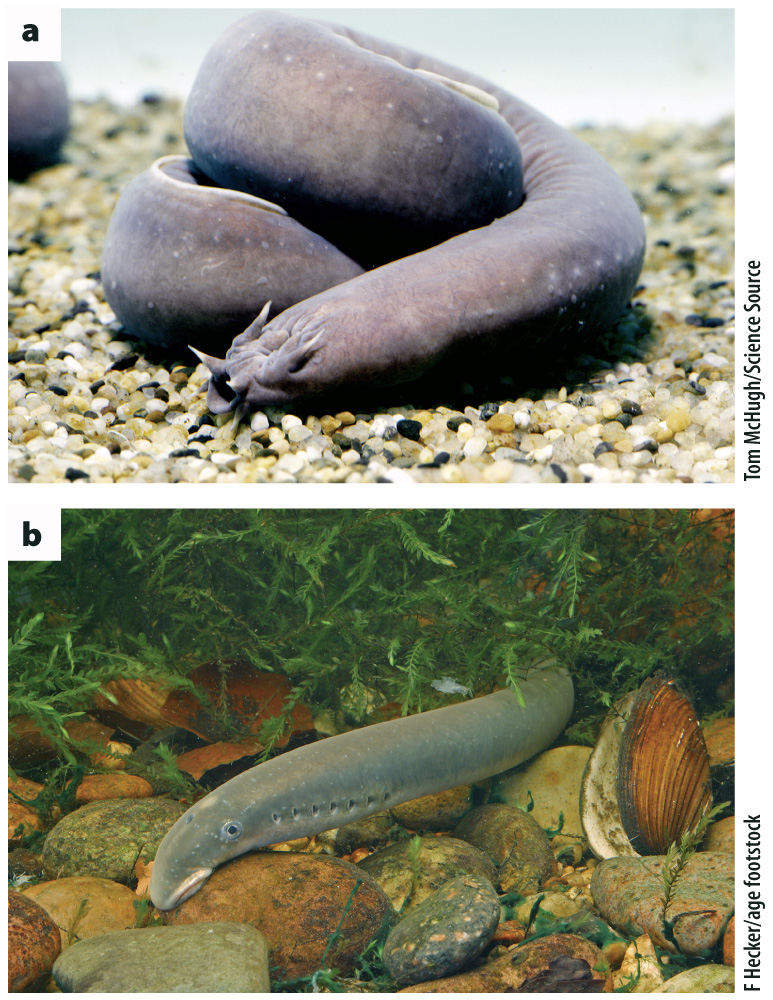Fish are the earliest-branching and most diverse vertebrate animals.
We sometimes think of fish as one group, but the aquatic animals we commonly call “fish” include four distinct groups of aquatic vertebrates, not all of them monophyletic (Fig. 44.31).

FIG. 44.31 A phylogeny of the vertebrates. This phylogeny is favored by recent molecular data, but, like all phylogenies, is a hypothesis. The placements of hagfish relative to other vertebrates and turtles relative to other sauropsids have provoked debate for many years.

FIG. 44.32 Hagfish and lampreys. Commonly grouped together as jawless fish, (a) hagfish and (b) lampreys are the earliest- branching vertebrates alive today.
The earliest-branching craniates are the hagfish and lampreys (Fig. 44.32). These animals have a cranium built of cartilage but lack jaws. Lampreys also have a vertebral column built of cartilage. Hagfish lack vertebrae, though current research suggests that this trait existed in a common ancestor of hagfish and lampreys but was lost in hagfish. These eel-like organisms feed on soft foods without the aid of jaws because they diverged before jaws evolved from pharyngeal slits. Hagfish feed on marine worms and on dead and dying sea animals, while lampreys live parasitically, sucking body fluids from fish prey. Both hagfish and lampreys have a series of gill slits through which water enters to bring oxygen to the gills.
Biologists have long debated the phylogenetic relationships among hagfish, lampreys, and other vertebrate animals. The presence of a vertebral column in lampreys convinced many biologists that lampreys are the sister group to other vertebrates, and hagfish the sister group to all vertebrates, including lampreys, but several lines of molecular data now favor the view shown in Fig. 44.31 that hagfish and lampreys together form the sister group to all other vertebrates. About 65 species of lampreys and hagfish live in fresh water and coastal oceans. Fossils record the existence of many extinct species of jawless fishes. When we include fossils, the jawless fishes as a whole are paraphyletic because one of their groups gave rise to fish with jaws.
Chondrichthyes, or cartilaginous fish, form the next deepest branch on the vertebrate tree. This monophyletic group includes about 800 species of sharks, rays, and chimaeras, all of which have jaws and a skeleton made of cartilage (Fig. 44.33). These fish deposit calcium phosphate minerals only in their teeth and in small toothlike structures called denticles embedded in the skin. The best-known cartilaginous fish are the sharks, many of which are predators that put those mineralized teeth to good use. On the other hand, the group also includes Whale Sharks, filter-feeding animals that, at a length up to 40 feet (12 m), are gentle giants of the sea. Rays are closely related to sharks but have a flattened body adapted for life on the seafloor, where they feed on clams and crabs. The cartilaginous fish can retain levels of urea in their tissues that would poison other vertebrates, a physiological adaptation that helps them to maintain their salt balance without well-developed kidneys (Chapter 41). Nearly all Chondrichthyes occur in the oceans, but Bull Sharks (Carcharhinus leucas) commonly swim into rivers—they’ve been recorded well up the Mississippi—and there are several freshwater species of rays.

FIG. 44.33 Cartilaginous fish. The skeletons and jaws of sharks are made of cartilage.
Moving up one more branch in the vertebrate tree, we encounter the Osteichthyes, or bony fish (see Fig. 44.31). Bony fish have a cranium, jaws, and bones mineralized by calcium phosphate. Numbering about 20,000–25,000 freshwater and seawater species, these are the fish that we most commonly encounter (Fig. 44.34). Bony fish are by far the most diverse group of vertebrates, possessing several unique features that facilitate their occupation of diverse niches. First, they have a system of movable elements in their jaws that allows them to specialize and diversify their feeding on many different types of food. Second, they possess a unique gas-filled sac called a swim bladder that permits exquisite control over their position in the water column through changes in buoyancy. Third, bony fish have kidneys that allow them to regulate water balance and so occupy waters over a wide range of salinity.

FIG. 44.34 Bony fish. The char, well known to those who fish in fresh water, illustrates the principal anatomical features of bony fish: a cranium, jaws, and mineralized bones.
The swim bladder plays a special role in vertebrate evolution. Early vertebrates evolved a gut sac that enabled them to gulp air to obtain additional oxygen. In some fish, this sac evolved into the swim bladder, but in one group the sac was modified to become a lung. Charles Darwin was among the first to recognize that the swim bladder and the vertebrate lung are homologous organs.



